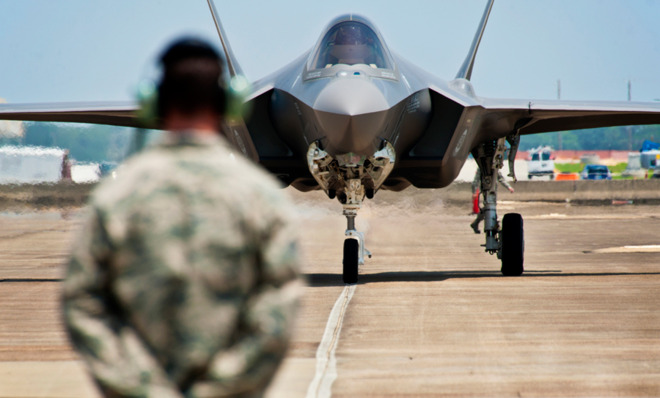The Pentagon's troubled, expensive new fighter jet
The F-35 has been plagued by problems. Will it ever get off the ground?

What is the F-35?
It's a state-of-the-art fighter jet that's supposed to seal America's dominance over the world's skies. Conceived in 1996, the Lockheed Martin F-35 Lightning II was to be put into operation starting in 2010 to gradually replace the Pentagon's aging fleet of fighters, such as the F-16 and the F/A-18, many of which were built in the 1970s and '80s. But in the 18 years since its conception, the F-35 has proven to be so technologically ambitious that Lockheed can't get it finished; there have been endless delays, budget overruns, and technical failures. The plane was recently grounded again, because of an engine fire — the 13th grounding since 2007. Since the F-35 has been repeatedly redesigned, the cost of developing the plane has doubled to a record-breaking $400 billion — the most expensive weapons system ever. A single plane will cost $185 million to produce. The F-35's deployment has been pushed back to 2015 at the earliest, with the Pentagon calling its performance "immature'' and "unacceptable,'' and many military experts question whether it will ever operate as intended. "Can't turn, can't climb, can't run," concluded one scathing Rand Corp. study.
How advanced is the F-35?
The Week
Escape your echo chamber. Get the facts behind the news, plus analysis from multiple perspectives.

Sign up for The Week's Free Newsletters
From our morning news briefing to a weekly Good News Newsletter, get the best of The Week delivered directly to your inbox.
From our morning news briefing to a weekly Good News Newsletter, get the best of The Week delivered directly to your inbox.
In theory, it will be the most lethal fighter ever made. The "do-it-all" fighter can both bomb land targets and engage in air-to-air combat, covering the diverse needs of the Navy, Air Force, and Marine Corps. Its radar-absorbing coating, coupled with its supersonic speed, allow the "stealth" fighter to swoop into combat zones before the enemy can detect it coming. The single-engine, single-seat plane carries groundbreaking software technology that's used to control a futuristic video screen inside the pilot's helmet. Information from several cameras mounted around the plane is fed back into that helmet, giving the pilot a 360-degree view during dogfights and bombing runs. "This aircraft reinforces the way Americans go to war," says Air Force Lt. Gen. Frank Gorenc. "We don't want to win 51-49. We want to win 99 to nothing."
Does the technology work?
It often does not. The helmet's video resolution, for example, is far worse than that of the naked eye, so pilots struggle to pick out the tiny dots in the distance that could represent an enemy threat. Many other malfunctions have been ironed out in the last decade or so of development. "This is an incredibly complex aircraft," says Air Force Col. Rod Cregier. "Getting it right isn't easy." Keeping it right won't be easy, either: The F-35 will cost up to 40 percent more to maintain than previous fighter jets have, and a Pentagon study estimated the lifetime maintenance cost of all the jets at $1 trillion. And even when it works properly, the F-35 is handicapped by one fatal design flaw.
What's that?
A free daily email with the biggest news stories of the day – and the best features from TheWeek.com
Its vertical takeoff equipment. The Marine Corps insisted the plane have "jump-jet" capability so that fighters could take off from the short landing decks of the Corps' amphibious assault ships. But vertically lifting a plane that weighs up to 35 tons requires about 40,000 pounds of thrust, so Lockheed added a powerful lift fan. The bulky fan assembly has increased the drag of the plane, making its acceleration, fuel efficiency, and flying range inferior even to older Chinese jets (see box). To rub salt into the wound, China is now developing its own rip-off of the F-35, based on Pentagon blueprints stolen by Chinese hackers. The J-31 comes without the F-35's compromising jump-jet lift fan; as a result, it's faster and more maneuverable.
What are the alternatives?
The Pentagon could restart production on the F-22 line, though that system has been dogged by its own problems — including its pilots regularly experiencing oxygen deprivation and blackouts while flying. Or military officials could skip the so-called Fifth Generation of fighters, like the F-35, and move straight to the sixth, which will apparently focus on giving jets laser weaponry. Other military experts argue that the Pentagon should drop its World War II–era dependence on piloted combat altogether, given that it's barely used in military conflicts around the world today, and instead focus on unmanned drone and robotic warfare. But both the Pentagon and Congress now seem irrevocably locked into the F-35 project.
Why is that?
Perverse as it sounds, the program has become too expensive to quit. Congressional lawmakers are also keenly aware that the project supports 133,000 jobs — a number that will grow to 260,000 when full-scale production begins — in 45 states, and are reluctant to sacrifice so many American jobs. Many of America's allies have also made commitments to buying the F-35, and it would damage U.S. prestige to cancel those sales. So the Pentagon is committed to producing 2,400 fighter jets that analysts say could actually weaken America's aviation advantage. "My prediction is the F-35 will be such an embarrassment," says aircraft engineer and defense analyst Pierre Sprey, "that it will be canceled before 500 are built."
Blown out of the sky
In 2008, two defense analysts at Rand Corp., a California-based think tank, created a computer program that would test the F-35's fighting ability in a hypothetical war with China. In the war game, American jet fighters based in Japan and Guam are provoked into a dogfight when Chinese missiles destroy the Taiwanese air force. After America's F-22s are themselves destroyed, 16 of the F-35s are left to fight it out with Chinese enemy jets — with devastating results. As soon as the simulated American fighters fire their missiles, they lose their stealth and become visible on radar detectors. Outflown by their Chinese rivals, the F-35s are blown out of the sky. America loses the war, and Taiwan falls to the Chinese. In the technical terminology of the study's two authors, the F-35 was judged "Double Inferior." Lockheed challenged the war game's results, claiming they were based on faulty assumptions. Rand then backed away from the report's conclusions, saying it didn't intend to make jet-to-jet comparisons.
Frances Weaver is a senior editor at The Week magazine. Originally from the U.K., she has written for the Daily Telegraph, The Spectator and Standpoint magazine.
-
 ‘Care fractures after birth’
‘Care fractures after birth’instant opinion Opinion, comment and editorials of the day
-
 Shots fired in the US-EU war over digital censorship
Shots fired in the US-EU war over digital censorshipIN THE SPOTLIGHT The Trump administration risks opening a dangerous new front in the battle of real-world consequences for online action
-
 What will the US economy look like in 2026?
What will the US economy look like in 2026?Today’s Big Question Wall Street is bullish, but uncertain